 Seth Swanson’s two consecutive second-place finishes at the 2014 and 2015 Western States 100 announced the arrival of an ultra heavyweight. He then went and put in an Ultra-Trail du Mont-Blanc debut this year that in many eyes was a part of the story of this year’s race. We caught up with Seth at his new home in Missoula, Montana to hear his fascinating journey into ultrarunning.
Seth Swanson’s two consecutive second-place finishes at the 2014 and 2015 Western States 100 announced the arrival of an ultra heavyweight. He then went and put in an Ultra-Trail du Mont-Blanc debut this year that in many eyes was a part of the story of this year’s race. We caught up with Seth at his new home in Missoula, Montana to hear his fascinating journey into ultrarunning.

Seth Swanson. Photo: iRunFar/Tim Peeters
iRunFar: You and your family have just moved into a new house in the woods. How is that going? Feeling like home yet?
Seth Swanson: Life is good where we are at, and I feel really fortunate. We were lucky to have quite literally stumbled across this property; I actually came across it while out on a run. We have a little house up a canyon just a few miles from downtown Missoula; a nice balance of rural living with ‘urban’ access. There is a trail that begins right out of our back door, which connects to endless miles of singletrack in the mountains. Just a mile up the road are some Nordic trails that get groomed if we actually get a normal winter. Our oldest daughter, Freya, who is four, will be starting lessons up there this winter. I am super excited about that. I have definitely become accustomed to the running, mountain-biking, and Nordic-skiing access right from the house, but just like any home we are still working to make it our own. Our property is primarily forested, so I have been working to thin out the trees to reduce the risk of wildland fire, which is a perennial threat here in Montana. That has been a slow process to wrestle these big trees as it is pretty much just a chainsaw and myself. It is satisfying work, and good practice in patience. Our latest project has been an installation of a large deer/bear/mountain-lion fence around an area that will encompass our garden, greenhouse, chicken coop, fruit trees, compost, etceteras. You know, all the things that attract those wild critters. I’m glad to be wrapping up with that and eager to get planting next year. Big plans are in the works for some tree forts and zip lines for our girls. My carpentry skills are pretty rough and often instigate some salty language, so my projects are best kept outside.
iRunFar: So, Montana. Have you always lived there? Can you give me some background on where you grew up?
Swanson: I grew up in eastern Wisconsin, just south of Green Bay. I think people’s only reference points in Wisconsin are Madison and the Packers, so if I say I grew up near the Packers, people tend to at least pretend that they know where it is. Norel and I actually grew up in the same town and went to the same schools since we were 12. We did share some mutual friends, but didn’t really connect until later in life. Norel was quite the runner then, running cross country and track. Her brothers were really into it as well, and they definitely have a competitive nature. It’s a lot of fun now. Anyway, I was on the seventh-grade cross-country team—just because they have an all-inclusive policy—and ran with Norel. Running didn’t really excite me then, and I was quite slow, which just about sums up my running career until just a few years back. I moved to Bozeman, Montana to attend Montana State University immediately after high school. I had visited Montana earlier on a family vacation, and it was pretty easy to fall for. Montana is immensely beautiful and maintains strong core values of hard work, environmental stewardship, community, and family. It is a special place, and one that was hard to leave.
[However,] I left Bozeman to attend graduate school at UC Davis in Davis, California. Upon graduation, I worked for the university continuing some research, and then took a job at a production nursery that is based out of western Montana. I lived in Missoula for a few months before transferring to Olympia, Washington to manage the greenhouse production and propagation for the same company. Thankfully, I was in Missoula long enough to cross paths with Norel. She gave me shit about my dancing skills, but it still worked out and we were able to connect. It’s pretty funny how the paths we choose can lead us in unlikely directions that forever change our lives. Before meeting Norel, I had often questioned my choices: should I have stayed in Davis to complete a PhD, should I have stayed on with the university as a researcher, should I have sought out a better job, should I have postponed graduate school to join the Peace Corps? She moved out to Olympia the following summer and we got married a couple years later at the place we met. We were in Olympia for four years before moving back to Missoula, right after our first daughter, Freya, was born.
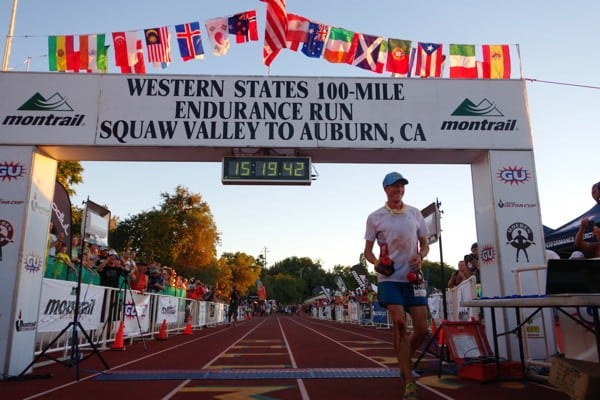
Seth Swanson taking a surprise second at the 2014 Western States 100. Photo: iRunFar/Bryon Powell
iRunFar: That’s cool. What type of kid were you? I know you skied a lot later on, but did your upbringing and early years involve a lot of nature and adventure?
Swanson: I feel like I led a pretty typical childhood for a Midwestern kid. Like most other kids, I played soccer, albeit I was awful. My specialty was getting in the way and eating oranges at half time. I too grew up in a semi-rural setting just outside of town. My brother, sister, and I would build forts out in the adjacent forests, and entertain ourselves until we heard the dinner bell ring. I spent a lot of time building poorly engineered jumps for my bike, which often preceded trips to the emergency room. Bike handling and construction were not really my forte, but I didn’t have much restraint in trying, anyways.
I grew up skiing with my family. As we were living in a heavily glaciated state, void of mountains, we did quite a bit of cross-country skiing. It was mostly just shuffling around the forest and complaining until we got to a hill to go down. We also made periodic trips to the hills of northern Wisconsin and the Upper Peninsula of Michigan for some ‘alpine’ skiing. I feel like I was immediately hooked on that, as I don’t recall any time that I did not want to ski. I think it was the freedom and energy that comes from cruising down the hill, through the trees, over little jumps, and being out in the snow. I was really fortunate that my parents took us on road trips in the summer and various other trips throughout the year. We would often go hiking, or camping, or skiing; but whatever it was, it often was outdoors. Maybe not wild adventures, but it was a great introduction to the beauty that exists outside of our childhood Midwestern bubble. Spending some time on Isle Royale in the middle of Lake Superior and hearing wolves howl or hiking in the Tetons are some of my cherished childhood memories spent with my family.
Growing up, my family lived out of town and got just a couple of grainy channels on the TV, so most of our time was spent outside. I really value that now, and we are actually in a similar position with our own kids. We live in a natural, forested setting on a mountainside, with no TV, marginal internet connectivity, and sparse cell-phone coverage at best. Our entertainment comes from each other, our imaginations, and being outside. We appreciate the intrinsic values that come with living in Montana and this is why we wanted to raise our kids here to begin with, and feel really fortunate for the events that brought us back here.

Before the start of the 2015 Western States 100. Photo: iRunFar/Marissa Harris
iRunFar: Cool. So skiing was a big passion. Can you tell me a bit more about how your skiing journey progressed to being more or less a college-student ski bum?
Swanson: I grew up skiing, first in a pack on my dad’s back, then shuffling around the yard, and finally on my own. We explored the Wisconsin countryside on cross-country skis and began ‘alpine’ skiing when I was three. I got a real idea of what skiing could be during some family ski trips to the mountains of Wyoming, Montana, Utah, and Colorado. I was really drawn to the mountains at a young age and more so of skiing. I remember watching old Scot Schmidt ski flicks over and over again and being totally blown away, and knowing that launching cliffs is what I wanted to do.
I tried ski racing when I was young, but it wasn’t really my style. I liked the freedom of being able to cruise around the mountain, and didn’t like the rigidity of the race course. It always seemed crazy to me to actually push away fresh snow to ski. I get it now, but it seemed really odd to me growing up.
I really began skiing when I was in college at Montana State University. Much to my parents chagrin, I scheduled my course load so that I would be left with the maximum amount of available time to ski. Never schedule classes in the morning! Skiing on a regular basis at Bridger Bowl, with friends who were pushing me, was a great experience. At that time, Bridger Bowl was even smaller than it is today, and we would spend most of the days hiking up to the ridgeline, traversing to various skiable lines, and accessing the side country. After my first year of college, I decided that skipping class was not the best use of time or finances, so I withdrew. I took a crappy job in Bozeman and unfortunately wound up working more than skiing. I eventually found my way back to school after I matured a bit and developed some more specific academic goals. After graduating, I took a job at the Yellowstone Club, a private ski resort in Big Sky. It was a pretty surreal experience, but I learned to tune skis and got to ski fresh snow every day.
I eventually went on to graduate school at UC Davis, and worked at another ski and bike shop while I was in school. I met some great friends there who I skied with often, and we really pushed each other, scared the shit out of each other, and had a lot of fun. There is some spectacular terrain in the Sierra Nevada, and it was great to explore the expansive lift access as well as backcountry terrain. I don’t think that I was that technically proficient of a skier, but I certainly pushed my limits. I felt like I really grew as a skier during this period and am really fortunate to have found good friends and experiences through skiing.
Now, as a dad, I am back at square one and have been primarily back on the rope tow the last couple of years. It is just as gratifying seeing our daughters get excited about skiing and learning to do so themselves. I can’t wait for the days when we can all ski together freely.
iRunFar: Sounds awesome! Had you any inkling at all during your skiing or mountain-biking years that you had a good ‘engine’ and a talent for endurance? Or did that come later?
Swanson: No, not really. Maybe when I’d go out backcountry skiing and we’d end up slogging for hours. I was able to handle that alright, but mostly attributed that to stubbornness rather than physical abilities. I didn’t really start mountain biking until I was in graduate school. I chased around friends who I skied with, who were possibly even more skilled on two wheels than skis. It was a steep learning curve. I got my first road bike at the same time and I remember just getting crushed by some friends. I felt like I just didn’t have biking legs, but I could move uphill on two feet alright.

About 40 miles into the 2015 Western States 100. Photo: iRunFar/Meghan Hicks
iRunFar: What was the experience of leaving Montana and heading to California like? Had you traveled much at that stage?
Swanson: After graduating from Montana State University, I was working on a lift-construction crew and tuning skis at a private ski resort. The pay was relatively decent and life was easy, but I felt like I was getting into a rut that I needed get out of quick. I sought out options and applied for the Peace Corps as well as some graduate schools. I was advancing in the Peace Corps process and was a few doctors’ visits away from accepting a role somewhere in Africa. About this time I received an acceptance letter from UC Davis, and felt that I needed to jump on that before they found out they made a mistake. So, I packed up and left Bozeman in August of 2004 and headed to Davis, California. I had never been to California before, and my first experience left me stuck in deadlock traffic with a U-Haul in tow outside of Sacramento in 100-plus-degree heat. At that moment, I thought I had made a terrible decision. That quickly changed, and I now really value my time spent in California and specifically Davis. It was a great learning experience on many different levels.
Growing up, I was really fortunate to have parents who were willing to travel with three kids, often times in a van, on the road for hours or days at a time. I had the opportunity to see so many inspiring places across the country, many of which I have returned to, and others I hope to return to.
After my first year of college, I needed some time away from school, so I temporarily dropped out. I took a lousy job and was working six days a week. This wasn’t really how I envisioned my time away from school, but I suppose it was a reality check. A friend was planning a trip to Nepal and asked if I wanted in. Not knowing a thing about Nepal, except that it is home to the highest point on earth, I jumped at the chance. I borrowed money, using my car (only possession) as collateral and headed over for two months. My parents were not excited about the prospect of three 19-year-old boys heading to Southeast Asia on their own, with no plan. But I went anyways. It was an amazing experience, and one that I will cherish forever: the people there were so welcoming and eager to share about their culture, and the environment is so diverse and obviously dramatic. We traveled around the country, towns and mountains, on foot and motorcycle.
iRunFar: Can you tell me about your first endurance or running event? How did it came about, had you trained for it, how did it feel, and what possibilities did it open up for you?
Swanson: I got into running after being encouraged to sign up for a local triathlon by a friend. At this point, Norel and I were living in Olympia, Washington. I copped out of the triathlon, but ran the duathlon instead. I was on a steel bike, circa 1993, that I borrowed from my brother-in-law. It was actually a lot of fun. I never considered myself a competitive person, but I felt the competitive drive then. The running part was what I really enjoyed. I did it again the following year and ended up winning it. Then I signed up for the Seattle Marathon and ran that in 2009. Then, my training was reckless. I’d go out for a long run, get back to the house, sit down, and have a beer to ‘stretch.’ I also was buying the cheapest shoes I could find, which in some cases were multiple sizes too small. I powered through it, but felt that I could do better. Shortly after this, I started running on trails and was really captured by that. It incorporated more of the freedom associated with being in the wild.
The following spring I ran another marathon, which seemed to go a little better. I was beginning to figure things out. That summer–2010–I spectated as my brother-in-law ran the Coeur d’Alene Ironman. The energy from the crowd and the racers was like nothing I ever experienced. I really had no business doing so, but the next day I registered for the 2011 CDA Ironman. I ran a half Ironman later that summer to figure things out a bit and have at least a little experience racing in the water.
In 2010, I began running on trails and was really drawn to that. I signed up for my first trail race, the Bridger Ridge Run, in Bozeman, Montana. I vaguely knew about this race while I was living in Bozeman, but never thought I’d actually run it. The only time I had been on that ridge was on skis in the winter. Regardless, I was registered for the race, but living about 30 feet above sea level in Olympia. I ran on some local trails and hills to prepare, but when I topped out on the first climb of that race, I felt knackered. Wobbly legs and a foggy head. I pushed on, got lost, and kept going. I was drastically unprepared, but it was a blast!
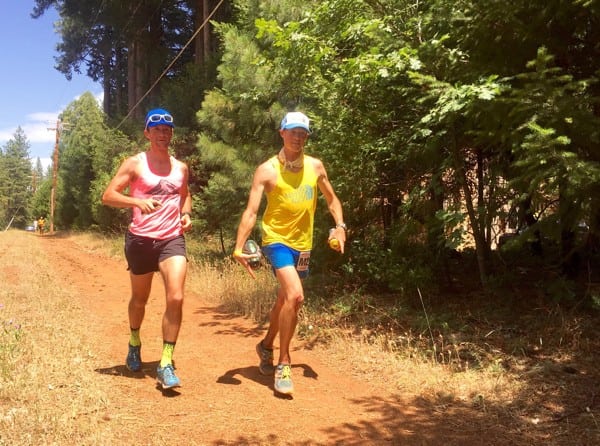
Mike Wolfe running Seth into Foresthill during the 2015 WS100. Photo: iRunFar/Meghan Hicks
iRunFar: You’ve said that one of the things you liked about running trails was the simplicity of it as a way of traveling through the wild. Are there any runs or occasions from those early running years that stand out as classic moments that emphasized that feeling?
Swanson: Well, since only being at it about five years, I like to think that I am still in the early years of my running. I guess thinking about traveling through the mountains or trails on bike and skis compared to running, there are just less moving parts. I have shoes and running shorts with me in my car at all times and can get out and go whenever the opportunity presents itself. I can travel across mountains, and with or without trail, most any time of year. Something that can’t be done on bike or skis. Of course running doesn’t quite compare to the inherent thrill of downhill travel associated with biking and skiing. Not much compares.
I guess one example was a year or so back when some friends and I ran into the Bob Marshall Wilderness Area, which is just to the north of Missoula. We accessed this area on trail up and over the Swan Mountains. Once into the wilderness area, we ran to lakes and ultimately traversed across ridgelines and mountainsides off trail. We came across sketchy terrain, spectacular views, and wolverine tracks, none of which would have been possible without traveling light and on foot. Good friends of mine, Mike Foote and Mike Wolfe, really exemplified this idea in their recent travels from Missoula to Banff, Canada. They traveled through this particular region I just mentioned and beyond. This sort of travel really allows for an intimate connection with the wild.
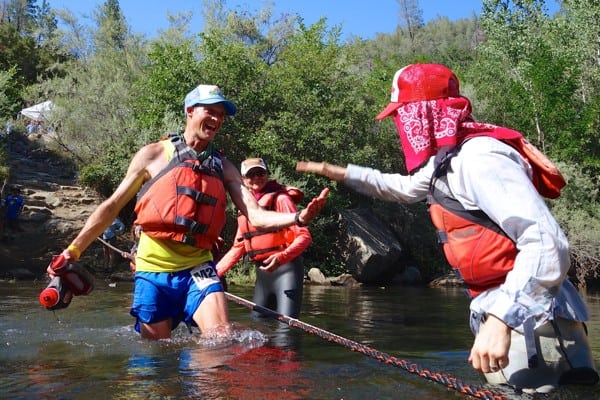
Crossing the river at the 2015 WS100. Photo: iRunFar/Bryon Powell
iRunFar: Sweet. How did your trail running progress from your first ‘ultra,’ the fat ass in Washington, to when you realized you had a talent for it and that you could be competitive and aim for some podiums?
Swanson: Oh man! It was the Capitol Peak Mega Fat Ass in Olympia. A friend of mine puts it on, and it is held at a recreation area outside of Olympia. I had spent a ton of time biking those trails, but was just getting into running. This event had been going on for some years, and drew some fast people out of Portland and Seattle who were looking to dust out the cobwebs. I was completely naïve going into this. At the start of the race, I was running with a small group of guys chatting and having a good time at a relatively casual pace. Anyways, I remember pulling away from these guys on a big climb. It was early in the race and I was feeling good. Experience would have kept me at a more conservative pace. This was a true fat ass and there wasn’t any aid albeit a jug of water or two. I didn’t put a whole lot of thought into it, and was packing just two gels. It was advertised at 55k, but maybe wound up to be a little longer. It really doesn’t matter. Either way, I blew up and just dragged myself to the finish. It was super fun, and I ended up meeting some guys who I have since become close friends with. Despite blowing up, it was the furthest I had ever run, and I was learning that we can push ourselves to do much greater things than we generally think is possible. I really appreciated the open and welcoming nature of the running community. This open nature really helped with our transition to Missoula. We were able to make some connections with folks relatively quickly and have some great friends to show for it. Two weeks later I ran another 50k and fared much better. Still got crushed, but not nearly as explosively.
From there, I ran a number of races, mostly regional races as they were more logistically manageable and it allowed for a reason to explore various pockets otherwise forgotten. The more I ran and raced, the more I learned about my strengths, weaknesses, and limits. I felt like I was gaining some good experience through trial and error. I did have some decent success, but competition was never too thick at these small, regional races. I started to become aware that people were running 100-mile races and that really intrigued me. In 2012, I ran my first 100-mile race. I got crushed, twisted my ankle, blew out my quads, and damn near walked the last 20 miles. Even though I may have told Norel I was only going to do one 100-mile race, I was intrigued by the complexity and challenges of that distance. I knew I could do better.
iRunFar: Alright, so 100 milers—now we’re talking. Two consecutive second-place finishes Western States and a fourth at UTMB have really put you on the map. Those two races are a world apart in terms of size and the whole circus that surrounds them. Can you tell me how it’s been to be at the sharp end of each race, your experiences at each, the contrasts that you experienced, and your likes and dislikes (if any)?
Swanson: “Circus” is definitely an appropriate description. That aspect, the cultural component, was part of what drew me to these races in the first place. Western States has such a deep history and attracts some significant competition as well as interest around the race. It seems to be about as close to ‘mainstream’ as U.S. ultrarunning gets. A few years back, I ran a race in rural Montana where I had to wake up the lone volunteer at the finish line to record my finish. Not before having to stop at the local watering hole, just prior to last call, to ask for directions. Rather anticlimactic after running a 100 miles in the mountains. Needless to say, I was interested in experiencing the other end of the spectrum in racing. Logistically, I was unable to make it to any of the 2014 Montrail Ultra Cup races, so I relied on good fortune to get into Western States. I would have rather earned my way into the race, but I’ll take the lucky draw from the 6% lottery odds. But, I was really lucky to have been able to earn my ticket back for 2015.
I’ll tell you what, second place at Western States feels like a win to me. Both years I felt like I had a great race and am absolutely satisfied. Of course I’d be lying to say I wouldn’t have rather won, but I am very happy with how things played out. Going into the race both years, I did not have the expectations to wind up where I did. The experience of 2014 in particular was very surreal, and the magnitude of the event and its results took a while to settle in. I had an absolute blast both years. A few years ago, I shied away from the spectacles and inadvertently the competition of racing, so this was a very different experience for me. It was great to have people from the community and other spectators out along the course cheering and being genuinely excited. It’s easy to get fired up rolling into an aid station that is just booming with excitement and energy.
UTMB was like nothing I have ever experienced before. Chamonix, for that matter, was like nothing I have ever experienced before. As soon as we got there and got out on the trails for some exploration of the valley, I knew I was unprepared. Everything there is so steep! And relentless. Besides that, the grandeur of the course was so dramatic. It was absolutely beautiful. There was a full moon during the race; so the night was just as pretty as the day as the silhouette of the mountains were the backdrop along the entire course. In addition to the beauty of the course, the cultural/social component really stood out. Experiencing the trails and the preparations of the race, you could tell that running on trails is held at a much higher regard there than in the U.S. All along the course, spectators were out cheering the runners along: the crowds lining the streets of Saint-Gervais seemed more fitting of a finish line than an aid station at the beginning of the race, and on top of remote mountain passes in the middle of the night, people were out there banging bells and cheering. That energy and excitement is contagious. The experience of that event in its entirety was so rich. I cherished the time I had with Norel around the time of the race to explore the beautiful countryside and have some time to ourselves. And of course the race itself burnt memories I’ll have forever. Nobody can take that away.
All in all, I am still learning as I go. I still make tons of mistakes, but try to use those to build in the future. I’ve been really fortunate to have run alongside some amazing athletes and I have definitely gained from their experience. But really, I’m having a ton of fun and that’s why I’m sticking with it.
I had the good fortune of gaining entry and logistics to UTMB from the Ultra-Trail World Tour, which wouldn’t have been possible without ending up in second at Western States in 2014. I can’t say enough how lucky I feel.
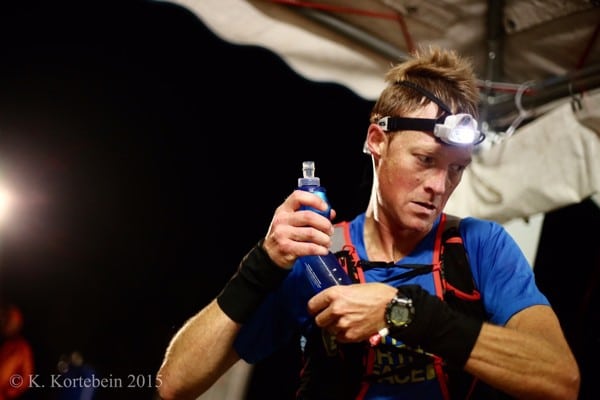
During the 2015 Ultra-Trail du Mont-Blanc. Photo: iRunFar/Kirsten Kortebein
iRunFar: How has sponsorship changed your approach and opportunities within ultrarunning? And how did your partnership with The North Face come about? Seems like they have a proper Montana posse with you and the two Mikes?
Swanson: Well, this is all new to me, and still seems pretty foreign. I am super fortunate to have the support from The North Face. If you would have asked me five years ago if I thought I would be where I’m at now, I would have laughed. Foote and Wolfe definitely played a significant role in connecting me with the folks at The North Face. I really owe it to them. I realize I’m not really the model athlete for sponsorship. I don’t have a dramatic back story, I don’t have a huge social-media presence, and I don’t have an iconic ‘image.’ I work hard, love what I do, and do what I can to give back to my family and the community. I wasn’t seeking the validation from sponsorship or felt any sort of entitlement to some, but was more interested in the opportunities that may open up as part of the arrangement. I am really lucky to be connected with a brand like The North Face that has not only been supporting trail and ultrarunning for some time, but has been at the forefront of adventure and exploration for decades. It is really cool to be part of a team of athletes with such amazing experience, class, and determination. Not only runners, but skiers, climbers, etceteras. I feel that I could learn so much from them, and am so excited about what the future may have in store. I truly believe in the authenticity of these sponsor/athlete relationships and feel that they should be mutually beneficial. I can wholeheartedly stand by the products, actions, and athletes that come from The North Face, and I hope that I can be a genuine ambassador of their mission and values.
Being with The North Face has definitely opened up doors to participation in events that I would not have otherwise. I really appreciate that, and look forward to future adventures and experiences that may come.
Maybe The North Face should have a field office in Missoula. Like I said, Foote and Wolfe are great friends of mine and I owe a lot to them. They stuck their necks out and campaigned for me. I hold a great deal of respect and gratitude toward them. Missoula has a great running community and I am fortunate to have a lot of good friends here, on and off of the trails.
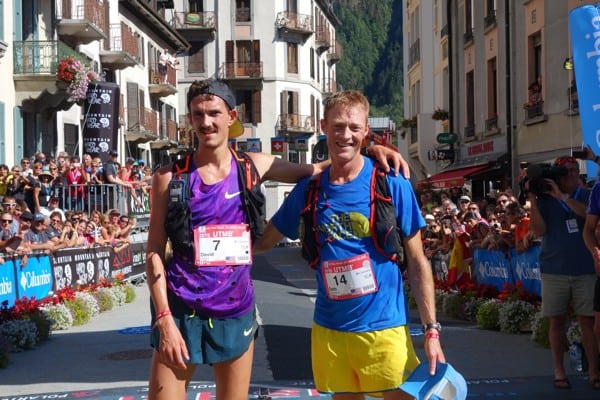
After finishing fourth and with third-place David Laney at the 2015 UTMB finish. Photo: iRunFar/Bryon Powell
iRunFar: With two young daughters, it seems like Norel, your wife, is super supportive. Does she still run? Do you ever get a chance to share some trails together?
Swanson: Oh man, I owe a lot to Norel. I am really fortunate to have met her. I really don’t know that I would be a runner if it wasn’t for her in my life. I certainly wasn’t before I met her. I was definitely influenced by her family, which has a long history of running. She has been extremely supportive throughout this process. It isn’t easy on our family. Trying to run competitively is quite selfish. It requires a lot of time, time away from family, and time Norel has to take away from other activities. The whole family takes on the burden, but it is the individual—me—who reaps the rewards. It is challenging to strike a balance with running, family, and a career. I have found this passion and drive in running which demands a ton of time, yet I have dedicated commitments to a career, and I ultimately want to spend as much time as possible with my family. I end up running early in the morning, during a lunch break at work, and on the weekend. Norel and I try to communicate what it is we all want to do and so we can fit in time for Norel, myself, and for us all to be together. Throw in two full-time careers and there isn’t much wiggle room. On top of that, Norel gave birth to our second daughter, Beatrice, while carrying out graduate studies before finishing this spring. I owe Norel and my daughters a lot, and I strive to make them proud and be there to play a supportive role in anything they pursue.
Besides really facilitating my ability to run on a daily basis, Norel provides much-needed support during races. Not so much from material items, but I gain so much strength from her and our girls. Their presence out on the course can be so uplifting and motivating. Norel is my sole crew. I have only run a few races without her, and I wouldn’t have chosen that. Logistically speaking, I keep things pretty simple during a race, but she is there to give me that emotional support and give me the strength I need to stay positive and keep going. Seeing her and our girls during a race is always a reminder of how lucky I am. I would have never imagined I’d be where I am at today. Our girls stayed at home with my parents while we traveled to Chamonix for UTMB. I really cherished our time there together, much more than just the race. I feel very fortunate to have had that opportunity, and to share it with her.
Norel does run. She always has. She ran a bit in junior high and high school, and in the last few years she has gotten into trail running. She has run a handful of shorter trail races and ran her first 50k at The Rut this past summer. It was so much fun being out there and seeing her power through that brutal course. And with a look of genuine enjoyment. I was so incredibly proud of her. It was really cool to see her push those self-induced limits and I am excited to see what’s next for her.
Unfortunately, we don’t get nearly enough time on the trails together. With two kiddos it is tough. There are occasions that we can sneak out when family is visiting, or we sometimes all get out together and I push the girls in the double stroller. I can’t wait for the days when her and I can get out and more so when all of us can get out together.

The whole family at the 2015 The Rut 50k. Left to right is Freya, Seth, Norel, and Beatrice. Photo: Tom Robertson
iRunFar: Sounds really cool. Away from racing and the trails, what do you work with, Seth?
Swanson: I assume you mean what do I do outside of running? Well, I have no trouble keeping busy, but for work, I work for Montana State University. The campus is actually located in Bozeman, and the University of Montana campus is located in Missoula. There aren’t any professional football (American) teams here in Montana, so people here take college football pretty seriously; I live in Missoula and work for the rival college. Anyways, I work for a branch of the university called Extension which is more or less the bridge between academic research and the community. I work with small-acreage and organic farmers, landowners, students, and other community members to provide technical support and educational opportunities. I also carry out farm research looking for means to support specialty crop producers.
My education is in horticulture and agronomy, and I was lucky enough to find a job in my field in a great location like Missoula. I did some research at UC Davis after graduating, then took a role in production agriculture for a number of years before stepping into my current role.
Norel is an elementary art teacher. She has taught all over, geographically and demographically, from the bush of Alaska to Bangkok, Thailand; from Madison, Wisconsin to Olympia, and now Missoula. She is great at what she does, and despite the tough days of public education, I believe she truly loves it.
iRunFar: So, apart from getting your home and garden up and going, what plans have you got for 2016?
Swanson: Believe me, it will be a huge accomplishment to get some plants in the ground next spring. This has been a slow, ongoing process for over a year now. I have a lot of work yet, but the end is near. This has definitely been a void in our life that will be nice to have fulfilled again.
I do have some things in mind for 2016, but there are a lot of moving parts, making absolute decisions a little tough. If it comes down to only racing one race, I’d like to do what I can to get back to UTMB. I had an amazing experience last year but left feeling a little less than satisfied. The finish was a tough pill to swallow, but made for lessons well learned. Right now, I am still green to the sport, eager to keep racing, and having a ton of fun. But, in the future, I’d definitely like to engage in some more adventurous outings that are more experiential than perhaps race orientated. I’m definitely excited for what the future can offer!
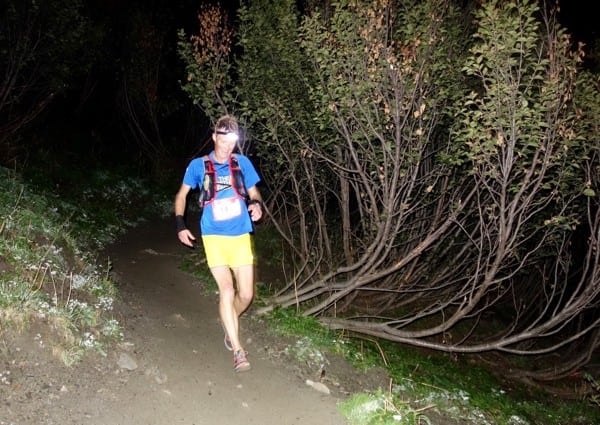
During the 2015 UTMB. Photo: iRunFar/Meghan Hicks
